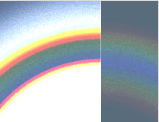Other Rainbow Orders
Other Rainbow Orders: Unveiling the Hidden Beauty of Atmospheric Optics
Rainbows have captivated the human imagination for centuries, with their vibrant colors and ethereal beauty. But did you know that there are more than just the primary and secondary bows that we commonly observe? In this article, we will explore the fascinating world of "Other Rainbow Orders" and uncover the hidden gems of atmospheric optics.
The 5th and 6th Order Bows: A Closer Look
While the primary and secondary bows dominate our usual rainbow sightings, there exist higher-order bows that are often overlooked. The 5th and 6th order bows, in particular, offer a mesmerizing display of colors, extending beyond the familiar arcs we are accustomed to.
These higher-order bows are much wider compared to their primary and secondary counterparts. They are formed by rays that graze the edges of water droplets, resulting in a more pronounced separation of colors as they enter and exit the droplets. This wide color separation gives these bows their unique and captivating appearance.
The Outer Red Rim: A Photographer's Delight
One striking feature of the 5th order bow is its outer red rim, which is produced by rays undergoing five internal reflections within the droplets. This outer rim has a radius of approximately 52.9º, slightly larger than the red inner rim of the secondary bow. This subtle difference in size adds to the allure of the 5th order bow.
Photographing these higher-order bows presents a challenge due to their relatively faint appearance compared to the primary and secondary bows. However, with the right combination of sky lighting and perhaps polarizing filters, capturing the beauty of the 5th order bow becomes a tantalizing possibility. It offers a unique opportunity to add a splash of green and blue within Alexander's dark band, nestled between the primary and secondary bows.
A Photographic Discovery: Harald Edens' Encounter
The existence of the 5th order bow was first hypothesized several years before it was positively identified in a photograph. Harald Edens, a keen observer of atmospheric optics, seized the opportunity to capture part of the elusive 5th order bow on August 8, 2012. His remarkable photograph not only confirmed the existence of this elusive phenomenon but also provided valuable insights into its characteristics.
Exploring the Window of Opportunity
The quest to capture the beauty of the 5th order bow continues to intrigue photographers and atmospheric optics enthusiasts alike. By utilizing advanced simulations like BowSim, we can visualize the intricate details of this phenomenon. These simulations reveal that the 5th order bow can be found within Alexander's dark band, offering a tantalizing window of opportunity for photographers to capture its splendor.
While the 5th order bow remains relatively rare and challenging to photograph, advancements in technology and techniques provide hope for future sightings and documentation. It is a testament to the endless wonders of atmospheric optics, reminding us that there is always more to discover and explore in the world around us.
In conclusion, the world of atmospheric optics is a treasure trove of hidden beauty and intricate phenomena. The 5th and 6th order bows, with their wide color separation and elusive nature, offer a glimpse into the awe-inspiring complexity of rainbows. As we continue to unravel the mysteries of the skies, let us never cease to be amazed by the wonders that lie just beyond our gaze.

5th & 6th order bows.
This BowSim simulation points away from the sun.
The unfiltered, 5% transmission view at left is dominated by the 'ordinary' primary and secondary bows.
At right the lower order bows were numerically filtered out (if only we could do that on the sky) to reveal the 5th and 6th order bows. the 5th order bow is outermost.
The 5th and 6th order bows are very wide compared to the primary and secondary. They are made by rays that are closer to the edges of the droplets. These glancing rays are more widely colour separated when they enter and leave the drops.
The outer red rim of the 5th order bow, produced by rays emerging after five internal reflections, has a radius of 52.9º, slightly greater than that the red inner rim of the secondary bow.
The 5th order bow's might therefore have a chance of being photographed. Its green and blue sections fall within Alexander's dark band between the primary and secondary. With the right combination of sky lighting and perhaps polarising filters it might be photographed. Try it!
The above was written several years before it was finally positively identified in a photograph.
Harald Edens saw the same opportunity and captured part of the 5th order bow on August 8, 2012. See the image and read full details here.

Window of opportunity? The unfiltered Bowsin simulation at left shows the 5th order bow inside Alexander's dark band.
Note: this article has been automatically converted from the old site and may not appear as intended. You can find the original article here.
Reference Atmospheric Optics
If you use any of the definitions, information, or data presented on Atmospheric Optics, please copy the link or reference below to properly credit us as the reference source. Thank you!
-
<a href="https://atoptics.co.uk/blog/other-rainbow-orders/">Other Rainbow Orders</a>
-
"Other Rainbow Orders". Atmospheric Optics. Accessed on November 26, 2024. https://atoptics.co.uk/blog/other-rainbow-orders/.
-
"Other Rainbow Orders". Atmospheric Optics, https://atoptics.co.uk/blog/other-rainbow-orders/. Accessed 26 November, 2024
-
Other Rainbow Orders. Atmospheric Optics. Retrieved from https://atoptics.co.uk/blog/other-rainbow-orders/.